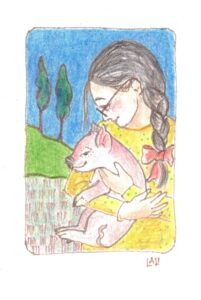I don’t know where the American medical establishment got its idea of the Mediterranean diet, but it doesn’t bear much resemblance to the Mediterranean diet of my Catalan childhood. Our table wasn’t loaded year-round with crunchy green vegetables, and we ate fruit only in season. We did consume tons of garlic and gallons of olive oil. And loaf after loaf of terrific crusty bread, which is a kind of vegetable after all, if you think about it.
For the rest, we ate animals. Lots of fish and things from the teeming wine-dark sea: monkfish, sardines, hake, baby octopuses, squid “in their ink,” clams, mussels, and who knows what else. I have written about how my maternal grandmother, who lived on a farm and raised chickens and rabbits, for the table, used to save the testes especially for me. In the winter, in Barcelona, to fortify me for the rigors of school, my mother would serve me “brain food”: ribbons of bone marrow sauteed in—what else—olive oil. And “brain puffs”—pig brains mixed with egg, lightly floured, and sauteed in o. o.
We hardly ever ate beef, which was tough, gristly, and which I chewed and chewed to a woody texture that I found impossible to swallow. In summer, in the country, we ate the diminutive ribs of practically newborn lambs and kids. Ribs were considered, for some reason, picnic food and were grilled under the house-sized fig tree where these picnics took place. And after a downpour we would hunt for snails, which we ate three days later, after they had been duly fasted to clean out their digestive tracts.
Winter and summer we ate a lot of pork, probably because my grandparents raised pigs. Every year my grandmother would send us a fabulous serrano ham, (which in the U.S. sells for an incredible $399 lb) and a variety of sausages made by herself: chorizo, a white sausage (butifarra blanca), and a thick black sausage (butifarra negra). The latter, I have since learned, was in fact blood pudding. It was sliced into circles and sauteed in o. o., and I loved its sweet, garlicky taste.
There was one pork delicacy, however, that we enjoyed only thanks to my grandfather’s profession. He was a veterinarian, and whenever pigs were slaughtered in the village people brought him samples of the pigs’ muscle tissue to certify that they were free of trichinella. Once the tests proved negative, there were all those lovely thin slices of pork to be—what, thrown out? That would have been a sacrilege. My grandmother would wash them well, bread them, and fry them. They were tender and delicious—veterinary schnitzel.
Ham, sausages, and the trichinella test slices—I loved it all. I also loved the brand-new piglets, freshly cleaned by their mother and sweet smelling, that my grandfather would put in my arms and let me hold for a few minutes. I never associated their human-looking pinkness and their perennial smile with those delicacies on my plate.
These days, to the detriment of my palate, I do. It’s been years since I ate pork, but every Sunday at brunch the smell of our CCRC’s house-smoked, maple-cured bacon makes my mouth water even as I opt for the dreary vegetarian quiche. Just as, forty years after having given up tobacco, I would like nothing better than to inhale a Benson & Hedges 100s, I salivate at the thought of bacon, or chorizo, or even my grandmother’s blood pudding. But my heart recoils at the idea of eating one of those pink beings, so often held in exceptionally cruel and inhumane confinement, and said to be as clever and capable of affection as a poodle or a German Shepherd. Eating pork would feel cannibalistic to me now, although that impression probably derives from having read somewhere that the taste of human—a.k.a. English long pig—is uncannily similar to that of pork.
Of those long-ago culinary delights, all that remains to me now, for health and ecological reasons, is the occasional tinned sardine (sustainably harvested and full of omega 3 oils), and, mercifully, all the garlic and olive oil I can stand.



2 Responses
Fascinating, Lali! You have my mouth watering!
I’m waiting for them to figure out how to make lab-grown meat.